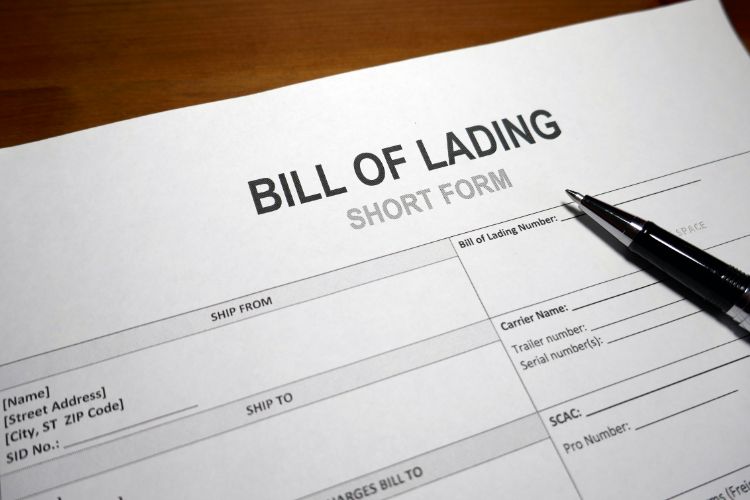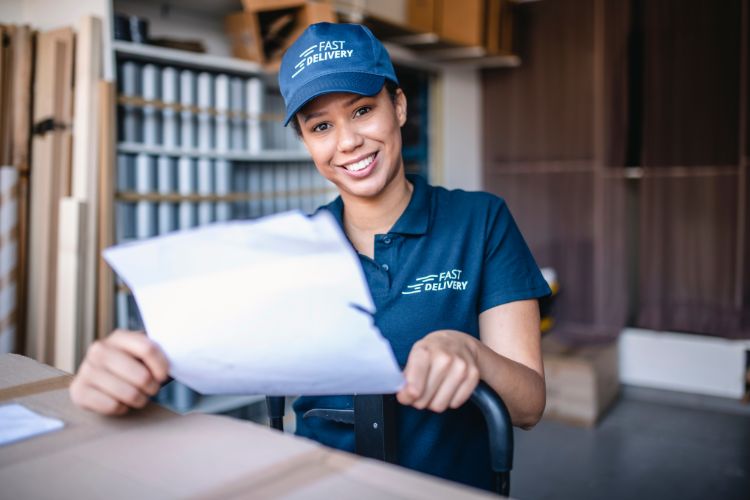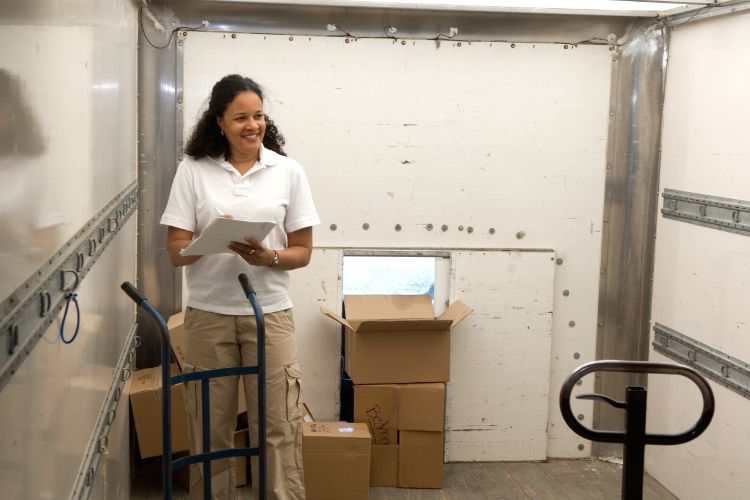What is the Bill of Lading?
The auto transport bill of lading acts as documentation of your vehicle’s condition, permission for the carrier to transport your vehicle, and a receipt of the shipping transaction with the carrier. In the unlikely event that any damages are incurred during transport, Bills Of Lading completed during pickup and delivery can help prove the condition of your car changed during shipment.
Documenting the car’s condition through the bill of lading is crucial as it serves as proof of the vehicle’s state at pickup and delivery, helping to resolve disputes over potential damages and ensuring accountability between the car owner and the transport company.
Please make sure that the condition of the vehicle recorded on the Bill of Lading is complete and accurate.
Key Components of a Bill of Lading
- Vehicle Information: This includes the type, make, model, year, color, and license plate number of the vehicle.
- Pickup and Delivery Locations: The bill of lading will detail the pickup and delivery addresses, ensuring that all parties are informed about the shipment’s locations.
- Insurance Company: The bill of lading may be referenced by the insurance company in case of inspections or claims related to the shipment.
Key Components of a Bill of Lading

A Bill of Lading is more than just a piece of paper; it’s a legally binding contract that outlines the terms and conditions of your vehicle’s shipment. Understanding its key components can help ensure a smooth and transparent transport process.
Here’s what you need to know:
- Shipper Information: This includes the name, address, and contact details of the person or company shipping the vehicle. Accurate shipper information is crucial for communication and record-keeping.
- Receiver Information: Similar to the shipper details, this section lists the name, address, and contact details of the person or company receiving the vehicle. Ensuring this information is correct helps avoid any delivery mishaps.
- Carrier Information: This part contains the name, address, and contact details of the carrier responsible for transporting your vehicle. Knowing your carrier’s details is essential for tracking and communication.
- Vehicle Information: This includes the make, model, year, and Vehicle Identification Number (VIN) of the vehicle being transported. Accurate vehicle information ensures that the right vehicle is being shipped and received.
- Pickup and Delivery Locations: The addresses and dates of pickup and delivery are recorded here. This information is vital for scheduling and tracking the shipment.
- Vehicle Condition: A detailed description of the condition during pickup and delivery is documented. This helps identify any changes or damages that may occur during transport.
- Special Instructions: Any special instructions or notes regarding the shipment are included in this section. This could be anything from handling instructions to specific delivery requirements.
The bill of lading is a legal document that acts as a contract and receipt for shipping. It contains essential details about the shipping process and serves as a legally binding record of the vehicle’s journey.
By ensuring all these components are accurately filled out, you create a clear and legally binding contract that protects both you and the carrier.
When is a Bill of Lading Filled Out With Pickup and Delivery Information?

A Bill of Lading, as a legal contract between the shipper and the transport company, should be completed during pickup and delivery. This means that for a shipment you should have two Bills of Lading – one from pickup and one from delivery.
You should carefully inspect your vehicle and review the Bill of Lading with your carrier. Do not sign a Bill of Lading that you do not agree with. Should you have any questions or concerns regarding your Bill of Lading, please contact us.
Remember to keep a signed copy or photo of the Bill of Lading for your records.
Pickup Instructions
Your Bill of Lading is your receipt and your evidence of the vehicle’s condition. Take time to walk around your car with the carrier to accurately document any existing damage to your car’s exterior on your Bill of Lading. We also highly recommend that you take detailed photos or videos of your car.
Make sure that the condition recorded on the Bill of Lading is complete and accurate because your signature means you agree to the documented condition. Do not sign a Bill of Lading that you do not agree with. Should you have any questions or concerns regarding your Bill of Lading, please contact us.
If you are electing to have someone else handle the pickup or delivery on your behalf, make sure to share these instructions with them and stress their importance.
Learn more in our guide about prepping your vehicle for pickup.
Delivery Instructions

Review the Bill of Lading with your carrier and ensure accurate delivery information, including pickup and delivery locations, specific times, and contact details. Compare the current state of your vehicle to the images or videos you took on pickup day.
This is your opportunity to document damages in the unlikely event that any are incurred during transport. Be sure any damage is clearly noted on the Bill of Lading. Make sure that the vehicle condition recorded on the Bill of Lading is complete and accurate.
Your signature on the Bill of Lading is your agreement to the vehicle condition post transport. Do not sign a Bill of Lading that you do not agree with. Should you have any questions or concerns regarding your Bill of Lading, please contact us.
If you are electing to have someone else handle the delivery on your behalf, make sure to share these instructions with them and stress their importance. Again, if your Bill of Lading is electronic such that the carrier is not able to hand you a copy of it, please take a picture of it for your own records.
Vehicle Condition and Inspection
The vehicle condition section of the Bill of Lading is a crucial document that safeguards both you and the carrier.
Here’s how to do it right:
- Detailed Description: Include a comprehensive description of the car’s condition, noting any existing damage or defects. This should cover everything from minor scratches to significant dents.
- Photos or Videos: Take clear, detailed photos or videos at the time of pickup and delivery. Visual evidence is invaluable in case of any disputes.
- Damage Record: Document any damage or issues that occur during transport. This should be noted on the Bill of Lading and supported by photos or videos.
- Signatures: Ensure that both the shipper and the carrier sign the Bill of Lading, acknowledging the vehicle’s condition. This makes the document a legally binding contract.
Conducting a thorough inspection at both pickup and delivery is essential. This not only ensures the car’s condition is accurately recorded but also helps prevent any disputes or false claims. Remember, a well-documented Bill of Lading is your best defense against any potential issues.
Electronic Bill of Lading

In today’s digital age, an electronic Bill of Lading (eBOL) offers a convenient and efficient way to manage your auto shipment.
Here’s what you need to know about eBOLs:
- Key Information: An eBOL includes all the essential details found on a traditional Bill of Lading, such as shipper and receiver information, carrier details, vehicle information, and pickup and delivery locations. This ensures that all critical information is documented and accessible.
- Electronic Signatures: Both the shipper and the carrier can sign the eBOL electronically. This not only speeds up the process but also ensures that the document is legally binding.
- Real-Time Tracking: One of the significant advantages of an eBOL is the ability to track the shipment in real-time. This provides peace of mind and allows for better planning and coordination.
- Automatic Updates and Notifications: An eBOL can provide automatic updates and notifications, keeping you informed about the status of your shipment at all times.
Using an eBOL can streamline the shipment process, reduce paperwork, and increase efficiency. However, it’s essential to ensure that the eBOL is secure and compliant with all relevant regulations and laws.
By embracing this digital solution, you can make your car transport experience smoother and more efficient.
Concerned About Your Shipment’s Bill of Lading?
Should you have any questions or concerns at any time during your transport process, Sherpa is here to help. You can reach us by emailing support@sherpaautotransport.com or calling us at (877) 850-1231 and choosing option two on the menu.
